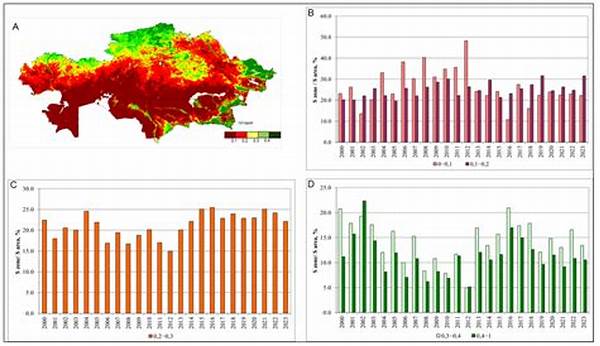Understanding the inherent intricacies of climate variability and drought detection is pivotal for developing strategic approaches to mitigate their adverse effects on the environment and society. Climate variability refers to the fluctuations in the climate system over time due to natural processes and anthropogenic influences. Droughts are among the most devastating manifestations of climate variability, affecting water resources, agriculture, and local communities. Consequently, detecting and forecasting droughts accurately play a crucial role in alleviating their impacts.
Read Now : Soil Moisture Retention For Sustainability
The Role of Technology in Detecting Droughts
Technological advancements have significantly enhanced the capabilities in the domain of climate variability and drought detection. Remote sensing, modeling, and geographic information systems are among the primary tools used to analyze climate patterns and predict droughts. These technologies aid in collecting and interpreting vast amounts of data, enabling researchers to understand the dynamics of climatic changes and provide early warnings of potential drought events. Consequently, stakeholders can implement timely measures to mitigate the adverse consequences, thereby fostering resilience within vulnerable communities and ecosystems.
Methods for Measuring Climate Variability and Drought
1. Remote Sensing Technology: Leveraging satellite data facilitates continuous monitoring of climate variability and drought detection across large geographic areas.
2. Climate Modeling: Employing sophisticated models helps simulate future climate scenarios and predict drought occurrences with improved accuracy.
3. Geographic Information Systems (GIS): GIS enables the visualization and analysis of spatial and temporal climate data for effective drought detection.
4. Meteorological Stations: These stations provide critical data on precipitation and temperature, essential for assessing climate variability and monitoring drought conditions.
5. Hydrological Analysis: Evaluation of water bodies’ levels and flows assist in understanding hydrological dynamics related to drought detection.
Impacts of Climate Variability on Ecosystems
Climate variability significantly influences ecosystems, prompting shifts in species distribution and changes in biodiversity. Droughts, a direct outcome of climate variability, exacerbate these impacts by reducing water availability critical for flora and fauna. As drought conditions become more prevalent, ecosystems may struggle to maintain their resilience, leading to alterations in species composition and potential biodiversity loss. Efficient drought detection systems are essential to help manage and sustain ecosystems by projecting possible future states, thus guiding conservation efforts and resource allocation to mitigate risks associated with climate variability.
Read Now : Enhancing Digital Services With Apis
Strategies for Mitigating Drought Impacts
Efficient management of water resources and agricultural practices are critical strategies for addressing the challenges posed by climate variability and drought detection. First, improving irrigation techniques can optimize water usage, thereby decreasing the adverse effects of droughts on crop production. Additionally, adopting drought-resistant crop varieties can bolster agricultural resilience against climate variability. Furthermore, community-based initiatives and policy frameworks are imperative in promoting sustainable water management and encouraging adaptive measures to combat drought conditions effectively. The interplay of technology and policy can fortify infrastructure and societal readiness against the multifaceted impacts of climate variability.
Policy Implications of Climate Variability
Policymakers must prioritize adapting to climate variability through informed decision-making and robust frameworks to address drought detection challenges. Comprehensive policies incorporating scientific research and technological advancements can enhance preparedness and response strategies. By fostering collaborations among governmental bodies, scientific communities, and local stakeholders, a coherent approach can be established, tailor-made to the unique needs of different regions. Integrating climate data into policy planning allows for proactive measures, helping safeguard communities from the detrimental effects of unpredictable climatic patterns. Furthermore, international cooperation is vital to share knowledge and resources, fostering a unified global response to the pressing issues of climate variability and drought.
Advances in Drought Detection Techniques
Continuous advancements in technology and methodologies have significantly improved the precision of drought detection, contributing to better preparedness and management strategies. Satellite imagery, paired with ground-based observations, facilitates real-time climate variability analysis, crucial for early drought detection. Machine learning algorithms are increasingly being utilized to enhance data interpretation, offering insights into potential future drought scenarios. Collaboration between climatologists and data scientists is driving innovation in predictive modeling, improving accuracy and reliability of forecasts, which are indispensable for planning and executing effective mitigation efforts.
Summary of Climate Variability and Drought Detection
In summary, climate variability presents multifaceted challenges that necessitate a comprehensive approach to understanding and managing its impacts, particularly through efficient drought detection mechanisms. The intricate interplay of technological innovation and policy development is crucial in addressing these challenges, underscoring the need for a concerted effort among various stakeholders. By focusing on enhancing detection capabilities, bolstering resilience through adaptive practices, and fostering collaborative policies, societies can better navigate the complexities imposed by climate variability and droughts, safeguarding both ecosystems and human communities from their potential adverse effects.
